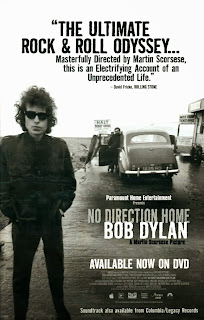22.11.13
"No direction home" by Martin Scorcese (2005)
Last night I watched excellent two-part documentary about early years of Bob Dylan titled "No direction home".
Now here is where I must explain that all these years Dylan somehow never appealed to me - to my biggest regret and embarrassment (what was I thinking?) he used to be annoying presence from 1960s that I never bought or perhaps it was huge idolatry that always followed him that I disliked. However, it was last year that I carefully started to explore his discography and since I am still under fresh impressions of his first few LP albums from early 1960s it was the perfect moment to see this documentary that basically covers this period.
Martin Scorcese "directed" or should we say "tailored" original footage pieces (in many occasions black-and-white snippets) into cohesive story that gives a glimpse into a world back than, Dylan's background and early influences. Dylan himself talks about these times and he comes across as clear-headed, witty and faintly intimidating - he skips completely any mention about his family, like they never existed and goes straight into arrival in New York where Greenwich Village was a centre of folk music and this is where instantly he found his natural place between hungry but enthusiastic beatniks, poets and all sorts of artists who embraced him for who he was, one of them. Although Dylan's motives for arrival in New York were completely different (he wanted to visit his idol Woody Guthrie) somehow destiny placed him right where he belonged and just watching the atmosphere around him in this eccentric centre of all kinds of creativity is a huge thrill to see.
There were literary a hundreds of young folkie artists around at this time so its a miracle that young, skinny and defiantly unglamourous Dylan got attention of "Columbia records" that eventually gave him chance to record and catapulted him into stardom. Not some private owned, independent company without distribution but "Columbia records" that charted huge hits behind commercial artists of the day, usually backed with angelic choruses and strings. Surely there was a whole team of people involved, including savvy manager who made sure that Dylan's songs were also covered and recorded by many pop artists but eventually listeners and record buyers would come back to the source. Folk queen Joan Baez became his biggest champion and proudly introduced him to her audience, for a while they were THE couple of 1960s. The documentary makes clear that Dylan could go on like a protest singer forever but something inside of him itched for a change and he had to follow his artistic muse that led him to completely another direction, so he left Baez and protest songs and moved into blues rock that alienated a lot of followers - reaction of the audience is stunning as they would literary take this change very personally and yell at him on a stage. At certain point of the movie the whirl around him (specially on tours) becomes truly uncomfortable with thousands of people having their own expectations and becoming frighteningly hostile, from autograph seekers to a journalists ("suck your sunglasses" somebody with a camera orders during a press conference) - this literate, clever and artistic young man faced a mass hysteria mixed with amazing patronising and deliberate misunderstandings. The movie ends in 1966 when motorcycle accident literary stops him in his tracks and forced him to re-think his next steps. Amazing not only because of historical perspective of politics, music industry and atmosphere at the time but also because lots of colleagues testify their experiences and views.
Subscribe to:
Post Comments (Atom)


No comments:
Post a Comment